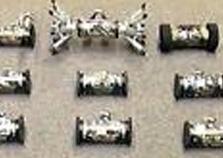December Update If you are not reading The Robot Report (and you should be; it’s one of the best things on the web about the robotic industry), you may have missed their article about the Fukushima Daiichi disaster. Much of what it says will not be news to the readers of this blog, but one paragraph caught my attention:
“In the case of Fukushima, both iRobot and QinetiQ, companies that volunteered equipment to Tepco, instructors found that senior Tepco employees were chosen to be trained to operate the American and British robots yet they were less suited to the task than the 20-year olds who had gamer experience. The remote-controlled PackBot and Talon robots and the RC Bobcat tractors, all used gaming consoles to operate their devices and the senior employees were slow to learn. In a recent Webinar on the issue by Robotic Trends, the trainers found that 20-year olds learned in less than a day while it took the older Tepco employees many days to gain the same level of competence.”
With the recent rapid growth of unmanned systems, there has been much speculation about the disruptive effects of their wide-spread adoption. A commonly-held view is that low-skilled workers will be displaced, while an educated elite (presumably people who make robots) will continue to thrive. Read more
 Why are unmanned systems developers offering so many different kinds of platforms and ideas, when there is comparatively little demand by the civilian market? Why are there more offerings than customers?
Why are unmanned systems developers offering so many different kinds of platforms and ideas, when there is comparatively little demand by the civilian market? Why are there more offerings than customers?

 “DoD will manage the force in ways that protect its ability to regenerate capabilities that might be needed to meet future, unforeseen demands, maintaining intellectual capital and rank structure that could be called upon to expand key elements of the force.”
“DoD will manage the force in ways that protect its ability to regenerate capabilities that might be needed to meet future, unforeseen demands, maintaining intellectual capital and rank structure that could be called upon to expand key elements of the force.”



 Are keyboards dead? In view of their ubiquity, and proven usefulness, this may seem to be an absurd question, but some people are considering this possibility. The success of the keyboard-less iPad in penetrating the
Are keyboards dead? In view of their ubiquity, and proven usefulness, this may seem to be an absurd question, but some people are considering this possibility. The success of the keyboard-less iPad in penetrating the 


 Here we are, well into the second decade of a new millennium, and not only is there a conspicuous absence of jet packs, but also no robot butler made my breakfast this morning. Domestic robots are not completely unknown, of course. There’s the famous vacuuming
Here we are, well into the second decade of a new millennium, and not only is there a conspicuous absence of jet packs, but also no robot butler made my breakfast this morning. Domestic robots are not completely unknown, of course. There’s the famous vacuuming 
 As reported previously in this
As reported previously in this 

